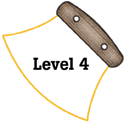
Alaska Science
Key Element A16
 |
Alaska Science |
|
Performance Standard Level 4, Ages 15–18
|
|
|
|
Sample Assessment Ideas
|
|
|
Expanded Sample Assessment Idea |
|
Procedure Students will:
|
Levels of Performance |
||
|
Stage 4 |
Student actively participates in mock trial and demonstrates mastery of the historical-viewpoint appropriate to his / her character or position within the courtroom. Student work is correct, complete and shows evidence of logical reasoning. | ||
|
Stage 3
|
Student actively participates in mock trial and demonstrates knowledge of the historical-viewpoint appropriate to his / her character or position within the courtroom. Student work shows evidence of logical reasoning but may contain minor errors or omissions. | ||
|
Stage 2
|
Student reluctantly participates in mock trial and demonstrates limited knowledge of the historical-viewpoint appropriate to his / her character or position within the courtroom. Student work may be incomplete, incorrect and may contain errors of science fact and reasoning. | ||
|
Stage 1
|
Student may be a non-participant in mock trial. Student work is largely incomplete, incorrect, shows little evidence of understanding and may contain major misconceptions. | ||
Standards Cross-References
|
||
|
National Science Education Standards The nuclear forces that hold the nucleus of an atom together, at nuclear distances, are usually stronger than the electric forces that would make it fly apart. Nuclear reactions convert a fraction of the mass of interacting particles into energy, and they can release much greater amounts of energy than atomic interactions. Fission is the splitting of a large nucleus into smaller pieces. Fusion is the joining of two nuclei at extremely high temperature and pressure, and is the process responsible for the energy of the sun and other stars. (Page 178) The total energy of the universe is constant. Energy can be transferred by collisions in chemical and nuclear reactions, by light waves and other radiations, and in many other ways. However, it can never be destroyed. As these transfers occur, the matter involved becomes steadily less ordered. (Page 180) Occasionally, there are advances in science, and technology that have important and long-lasting effects on science and society. Examples of such advances include the following:
|
Benchmarks As a young man, Albert Einstein, a German scientist, formulated the special Theory of Relativity, which brought about revolutionary changes in human understanding of nature. A decade later, he proposed the general Theory of Relativity, which, along with Newton’s work, ranks as one of the greatest human accomplishments in all of history. (Page 245) Among the surprising ideas of special relativity is that nothing can travel faster than the speed of light, which is the same for all observers no matter how they or the light source happen to be moving. (Page 245) The special Theory of Relativity is best known for stating that any form of energy has mass, and that matter itself is a form of energy. The famous relativity equation, E = mc2, holds that the transformation of even a tiny amount of matter will release an enormous amount of other forms of energy, in that the c in the equation stands for the immense speed of light. (Page 245) General relativity theory pictures Newton’s gravitational force as a distortion of space and time. (Page 245) Many predictions from Einstein’s Theory of Relativity have been confirmed on both atomic and astronomical scales. Still, the search continues for an even more powerful theory of the architecture of the universe. (Page 245) The basic idea of mathematical modeling is to find a mathematical relationship that behaves in the same ways as the objects or processes under investigation. A mathematical model may give insight about how something really works or may fit observations very well without any intuitive meaning. (Page 270) |
|
Table of Contents | Return to Alaska Native Knowledge Network